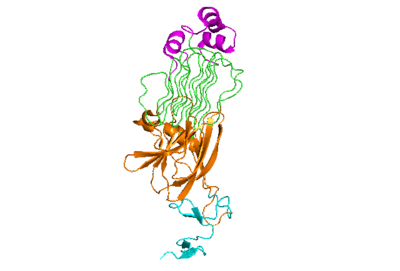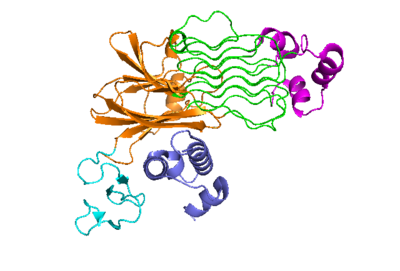Sandbox Reserved 1712
From Proteopedia
(Difference between revisions)
| Line 9: | Line 9: | ||
The extracellular portion of ALK has an inactive state, which is its monomerized form, and an active dimerized state with its ligands bound. The monomer is shown to the right in Figure 1, which has many different domains. The growth factor-like domain (EGF) connects the extracellular domains to the transmembrane domain (cyan). The tumor necrosis factor-like domain (TNFL) has a beta-sandwich structure that provides important residues that act as the binding surface for the ligand (orange). The glycine-rich domain (GlyR) contains 14 rare polyglycine helices that are hydrogen-bound to each other (green). The <scene name='90/904318/Glycinerichdomain/1'>hexagonal orientation</scene> of these rare helices create a very rigid structure that is important for ALK function. The polyglycine extension loop (PXL) connects two of these polyglycine helices (pink). | The extracellular portion of ALK has an inactive state, which is its monomerized form, and an active dimerized state with its ligands bound. The monomer is shown to the right in Figure 1, which has many different domains. The growth factor-like domain (EGF) connects the extracellular domains to the transmembrane domain (cyan). The tumor necrosis factor-like domain (TNFL) has a beta-sandwich structure that provides important residues that act as the binding surface for the ligand (orange). The glycine-rich domain (GlyR) contains 14 rare polyglycine helices that are hydrogen-bound to each other (green). The <scene name='90/904318/Glycinerichdomain/1'>hexagonal orientation</scene> of these rare helices create a very rigid structure that is important for ALK function. The polyglycine extension loop (PXL) connects two of these polyglycine helices (pink). | ||
[[Image:Prote_ALK_Monomer_White.png|400 px|right|thumb|Figure 1: The ALK monomer unbound to ALKAL. Cyan: growth factor-like domain (EGF). Orange: tumor necrosis factor-like domain (TNFL). Green: glycine-rich domain (GlyR). Pink: polyglycine extension loop (PXL).]] | [[Image:Prote_ALK_Monomer_White.png|400 px|right|thumb|Figure 1: The ALK monomer unbound to ALKAL. Cyan: growth factor-like domain (EGF). Orange: tumor necrosis factor-like domain (TNFL). Green: glycine-rich domain (GlyR). Pink: polyglycine extension loop (PXL).]] | ||
| - | The domains that aren't shown in Figure 1 but are shown in the domain map (Figure 2) that also make up the monomer are the heparin binding domains (HBDs), which are at the N-terminal end of the monomer. Heparin has been found to be a possible activating ligand of ALK.<ref>DOI: 10.1126/scisignal.2005916</ref> The transmembrane domain (TMH) are the residues of ALK that are located within the membrane. The kinase domain is the intracellular portion of ALK that contains the Tyr residues which are auto-phosphorylated when ALK is activated, initiating a signaling cascade. | + | The domains that aren't shown in Figure 1 but are shown in the domain map (Figure 2) that also make up the monomer are the heparin binding domains (HBDs), which are at the N-terminal end of the monomer. Heparin has been found to be a possible activating ligand of ALK.<ref>DOI: 10.1126/scisignal.2005916</ref> The transmembrane domain (TMH) are the residues of ALK that are located within the membrane. The kinase domain is the intracellular portion of ALK that contains the Tyr residues which are auto-phosphorylated when ALK is activated, initiating a signaling cascade. <ref>DOI: 10.1038/s41586-021-04141-7</ref> |
[[Image:Proteo_ALK-ALKAL_Monomer_White.png|400 px|right|thumb|Figure 2: ALK-ALKAL complex, showing the conformation change of ALK from the binding of ALKAL.]] | [[Image:Proteo_ALK-ALKAL_Monomer_White.png|400 px|right|thumb|Figure 2: ALK-ALKAL complex, showing the conformation change of ALK from the binding of ALKAL.]] | ||
===Conformational Change=== | ===Conformational Change=== | ||
| Line 18: | Line 18: | ||
Once the ALKAL binds with ALK and dimerizes with another ALK-ALKAL complex, this activated conformation also initiates a conformational change of the intracellular kinase domain of ALK. This causes an autophosphorylation of several tyrosine residues of this domain, activating a signaling cascade with its kinase activity. | Once the ALKAL binds with ALK and dimerizes with another ALK-ALKAL complex, this activated conformation also initiates a conformational change of the intracellular kinase domain of ALK. This causes an autophosphorylation of several tyrosine residues of this domain, activating a signaling cascade with its kinase activity. | ||
== Disease == | == Disease == | ||
| - | There are many <scene name='90/904318/mutations/2'>mutated residues</scene> that could take place causing constitutive receptor activation, enhancement between the interaction of receptors or stabilization of active receptors are known to relate to oncogenic potentials (Figure 4). The <scene name='90/904318/His694/2'>His694</scene> that is mutated to an arginine is known to be a gain-of-function in lung adenocarcinoma which can lead to constitutive activation of ALK. The <scene name='90/904318/Phe856/1'>Phe856</scene> that is mutated to the a serine may cause a gain-of-function mutation that is linked to acute myeloid leukemia. When the <scene name='90/904318/Arg753/2'>Arg753</scene> is mutated to a glutamate it is commonly identified in histiocytic neoplasms. The <scene name='90/904318/Gly747/1'>Gly747</scene> changing to arginine could cause possible oncogenic potentials which are not specified yet. The F856S and R753Q mutations are known to increase cytokine-dependent cell proliferation in certain cells. <ref>DOI: 10.1038/s41586-021-03959-5 | + | There are many <scene name='90/904318/mutations/2'>mutated residues</scene> that could take place causing constitutive receptor activation, enhancement between the interaction of receptors or stabilization of active receptors are known to relate to oncogenic potentials (Figure 4). The <scene name='90/904318/His694/2'>His694</scene> that is mutated to an arginine is known to be a gain-of-function in lung adenocarcinoma which can lead to constitutive activation of ALK. The <scene name='90/904318/Phe856/1'>Phe856</scene> that is mutated to the a serine may cause a gain-of-function mutation that is linked to acute myeloid leukemia. When the <scene name='90/904318/Arg753/2'>Arg753</scene> is mutated to a glutamate it is commonly identified in histiocytic neoplasms. The <scene name='90/904318/Gly747/1'>Gly747</scene> changing to arginine could cause possible oncogenic potentials which are not specified yet. The F856S and R753Q mutations are known to increase cytokine-dependent cell proliferation in certain cells. <ref>DOI: 10.1038/s41586-021-03959-5</ref> |
[[Image:Mutations.png|800 px|left|thumb]] | [[Image:Mutations.png|800 px|left|thumb]] | ||
</StructureSection> | </StructureSection> | ||
== References == | == References == | ||
<references/> | <references/> | ||
Revision as of 04:58, 28 March 2022
| This Sandbox is Reserved from February 28 through September 1, 2022 for use in the course CH462 Biochemistry II taught by R. Jeremy Johnson at the Butler University, Indianapolis, USA. This reservation includes Sandbox Reserved 1700 through Sandbox Reserved 1729. |
To get started:
More help: Help:Editing |
Anaplastic Lymphoma Kinase
| |||||||||||
References
- ↑ Murray PB, Lax I, Reshetnyak A, Ligon GF, Lillquist JS, Natoli EJ Jr, Shi X, Folta-Stogniew E, Gunel M, Alvarado D, Schlessinger J. Heparin is an activating ligand of the orphan receptor tyrosine kinase ALK. Sci Signal. 2015 Jan 20;8(360):ra6. doi: 10.1126/scisignal.2005916. PMID:25605972 doi:http://dx.doi.org/10.1126/scisignal.2005916
- ↑ Li T, Stayrook SE, Tsutsui Y, Zhang J, Wang Y, Li H, Proffitt A, Krimmer SG, Ahmed M, Belliveau O, Walker IX, Mudumbi KC, Suzuki Y, Lax I, Alvarado D, Lemmon MA, Schlessinger J, Klein DE. Structural basis for ligand reception by anaplastic lymphoma kinase. Nature. 2021 Dec;600(7887):148-152. doi: 10.1038/s41586-021-04141-7. Epub 2021, Nov 24. PMID:34819665 doi:http://dx.doi.org/10.1038/s41586-021-04141-7
- ↑ Reshetnyak AV, Rossi P, Myasnikov AG, Sowaileh M, Mohanty J, Nourse A, Miller DJ, Lax I, Schlessinger J, Kalodimos CG. Mechanism for the activation of the anaplastic lymphoma kinase receptor. Nature. 2021 Dec;600(7887):153-157. doi: 10.1038/s41586-021-04140-8. Epub 2021, Nov 24. PMID:34819673 doi:http://dx.doi.org/10.1038/s41586-021-04140-8
- ↑ Reshetnyak AV, Rossi P, Myasnikov AG, Sowaileh M, Mohanty J, Nourse A, Miller DJ, Lax I, Schlessinger J, Kalodimos CG. Mechanism for the activation of the anaplastic lymphoma kinase receptor. Nature. 2021 Dec;600(7887):153-157. doi: 10.1038/s41586-021-04140-8. Epub 2021, Nov 24. PMID:34819673 doi:http://dx.doi.org/10.1038/s41586-021-04140-8
- ↑ De Munck S, Provost M, Kurikawa M, Omori I, Mukohyama J, Felix J, Bloch Y, Abdel-Wahab O, Bazan JF, Yoshimi A, Savvides SN. Structural basis of cytokine-mediated activation of ALK family receptors. Nature. 2021 Oct 13. pii: 10.1038/s41586-021-03959-5. doi:, 10.1038/s41586-021-03959-5. PMID:34646012 doi:http://dx.doi.org/10.1038/s41586-021-03959-5




